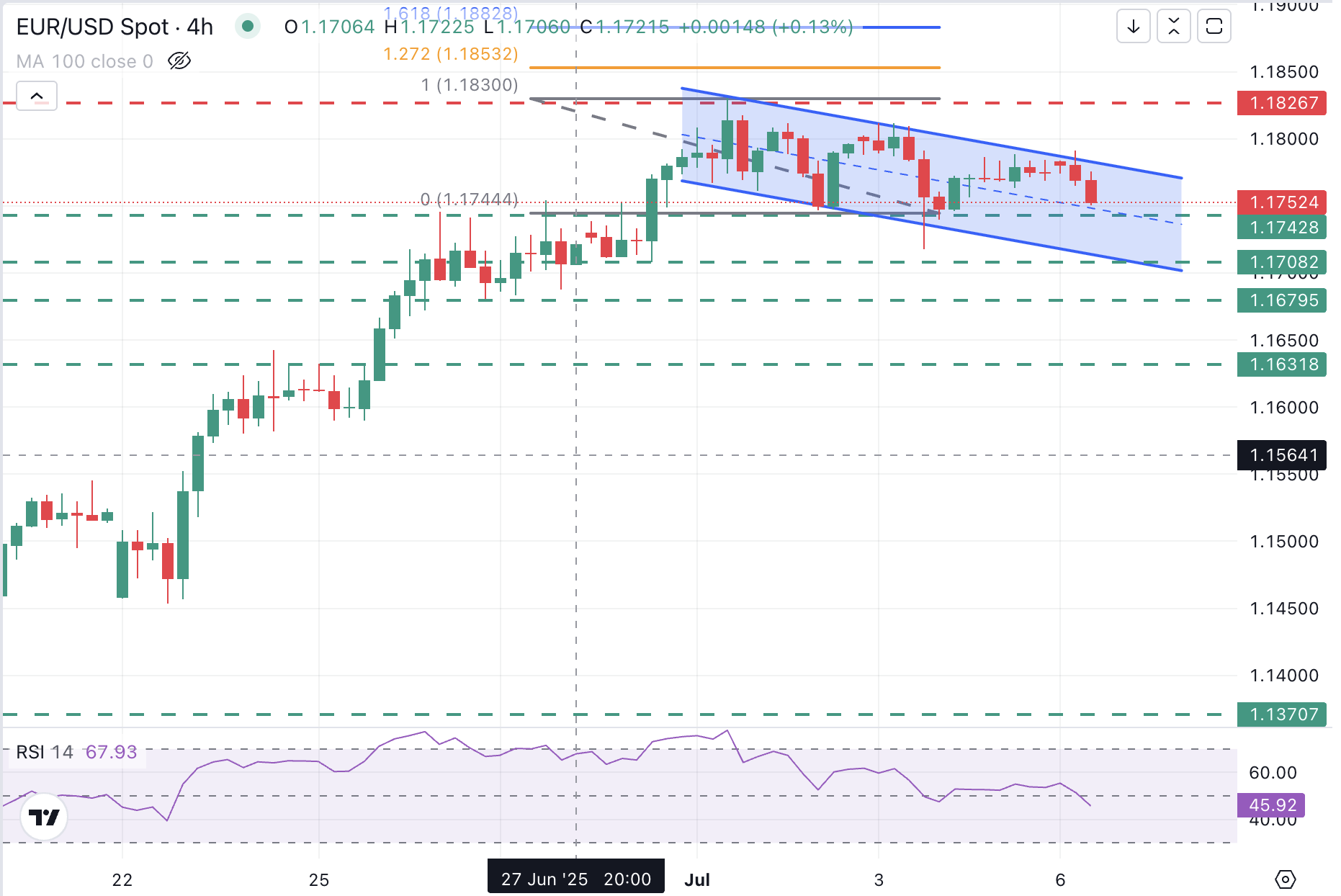- The euro accelerates its downward trend while investors prepare for US tariffs.
- An unexpected increase in German industrial production has failed to support the euro.
- The president of the USA, Trump, will send letters to the commercial partners informing them about the level of tariffs.
The Eur/USD It is accelerating its reversal on Monday, although it continues to quote within the range last week. The US dollar fails to distance itself significantly from the long -term minimal, since the enthusiasm for solid employment data and services of the USA.
The euro (EUR) retreated from levels just below 1,1800 early Monday and is quoting in the middle part of 1,1700, in 1,1755 at the time of writing, with technical indicators that show a growing bearish impulse.
It is expected that the US president, Donald Trump, will begin sending letters to the commercial partners on Monday, informing them about the tariffs applied to their products. The deadline to introduce these tariffs is Wednesday, but the comments of the Secretary of the Treasury, Scott Besent, suggesting that tariffs will be applied as of August 1, have added uncertainty to the matter, which keeps tension investors.
Almost three months after Trump announced a moratorium on tariffs, only three countries have closed commercial agreements with the US: China, the United Kingdom and Vietnam. In the case of China, the agreement was based more on a decala of the previously tax tariffs than on a commercial agreement itself.
However, US administration continues to promote imminent agreements in the next few days. Market sources suggest that India could be close to a mini agreement, and Bessent mentioned advances with the European Union.
Looking at the economic calendar, German industrial production exceeded expectations with an unexpected return to growth in May. Later today, the Eurozone retail sales data and the Sentix investor trusted index will give more information about the impulse of the eurozone economy. It is likely that the market will be more sensitive to negative data in the middle of the feeling of risk aversion caused by the renewed uncertainty about global trade.
Euro price today
The lower table shows the percentage of euro change (EUR) compared to the main currencies today. Euro was the strongest currency against the Australian dollar.
| USD | EUR | GBP | JPY | CAD | Aud | NZD | CHF | |
|---|---|---|---|---|---|---|---|---|
| USD | 0.13% | 0.26% | 0.65% | 0.30% | 0.82% | 0.83% | 0.18% | |
| EUR | -0.13% | 0.14% | 0.27% | 0.15% | 0.75% | 0.69% | 0.03% | |
| GBP | -0.26% | -0.14% | 0.12% | 0.03% | 0.62% | 0.56% | -0.23% | |
| JPY | -0.65% | -0.27% | -0.12% | -0.11% | 0.39% | 0.41% | -0.41% | |
| CAD | -0.30% | -0.15% | -0.03% | 0.11% | 0.53% | 0.53% | -0.26% | |
| Aud | -0.82% | -0.75% | -0.62% | -0.39% | -0.53% | 0.05% | -0.84% | |
| NZD | -0.83% | -0.69% | -0.56% | -0.41% | -0.53% | -0.05% | -0.79% | |
| CHF | -0.18% | -0.03% | 0.23% | 0.41% | 0.26% | 0.84% | 0.79% |
The heat map shows the percentage changes of the main currencies. The base currency is selected from the left column, while the contribution currency is selected in the upper row. For example, if you choose the euro of the left column and move along the horizontal line to the US dollar, the percentage change shown in the box will represent the EUR (base)/USD (quotation).
What moves the market today: the euro extends losses in risk aversion markets
- The EUR/USD is quoting at the lowest levels of the negotiation range last week, with cautious investors to assume risks on Monday, waiting for more clarity on the size of US tariffs, the specific deadline and target countries that will be affected.
- The US Treasury Secretary said during the weekend that countries that did not close agreements with the US will face the tariffs announced on Friday, but Trump indicated an additional tax of 10% to the countries that are aligned with the BRICS. Besent also said they will announce significant trade agreements in the next few days.
- In the Eurozone, the data of the German statistics office revealed that the industrial production of the country grew 1.2% in May, compared to the market expectations of a flat result and after a 1.6% contraction in the previous month. However, the impact on the euro has been moderate.
- Later today, Eurozone retail sales are expected to show a 0.7% drop in May, after an advance of 0.1% in April. In interannual terms, the growth of retail consumption is expected to be decelerated to 1.2% from 2.3% in the previous month.
- The data published in the US last week showed a resistant labor market, with private payroll growing in 147,000 in June, well above the growth of 110,000 planned by the market. The unemployment rate fell to 4.1%from 4.2%, compared to market expectations of an increase to 4.3%.
- These figures limited the hopes of an interest rate cut by the Federal Reserve (FED) in July and provided some support to the US dollar at the end of last week. Future markets are now valuing less than 5% possibilities of a 25 basic points cut this month, compared to 20% before the data, according to the Fed Watch tool of the CME Group. Betting for a cut in September have been reduced to less than 70% from approximately 95% before the data.

EUR/USD correct down, with 1,1740 in the focus of bassists
The EUR/USD is in a bassist correction since the maximum of last week in 1,1830. The technical indications show a growing bearish impulse, since the relative force index (RSI 14) of 4 hours has fallen to negative territory, at levels below 50, and the price action is close to the minimum of July 2 in 1,1740.
Below this level, there is space for a bearish extension that re -tests the bottom of the descending channel from the aforementioned maximum of July 1, now in 1,1715, which is close to the minimum of June 30, in 1,1710. The following support is the area between June 26 and 27 in 1,1680-1.1685.
On the positive side, the torque should break the upper part of the channel in 1,1785 and the maximum intradic in 1,1790 to challenge the immediate bearish trend. That would set its goal in the resistance area of 1,1815-1.1825, which kept the Alcistas on July 1, 2 and 3.
Tariffs – Frequently Questions
Although tariffs and taxes generate government income to finance public goods and services, they have several distinctions. Tariffs are paid in advance in the entrance port, while taxes are paid at the time of purchase. Taxes are imposed on individual taxpayers and companies, while tariffs are paid by importers.
There are two schools of thought among economists regarding the use of tariffs. While some argue that tariffs are necessary to protect national industries and address commercial imbalances, others see them as a harmful tool that could potentially increase long -term prices and bring to a harmful commercial war by promoting reciprocal tariffs.
During the election campaign for the presidential elections of November 2024, Donald Trump made it clear that he intends to use tariffs to support the US economy. In 2024, Mexico, China and Canada represented 42% of the total US imports in this period, Mexico stood out as the main exporter with 466.6 billion dollars, according to the US Census Office, therefore, Trump wants to focus on these three nations by imposing tariffs. It also plans to use the income generated through tariffs to reduce personal income taxes.
Source: Fx Street
I am Joshua Winder, a senior-level journalist and editor at World Stock Market. I specialize in covering news related to the stock market and economic trends. With more than 8 years of experience in this field, I have become an expert in financial reporting.







